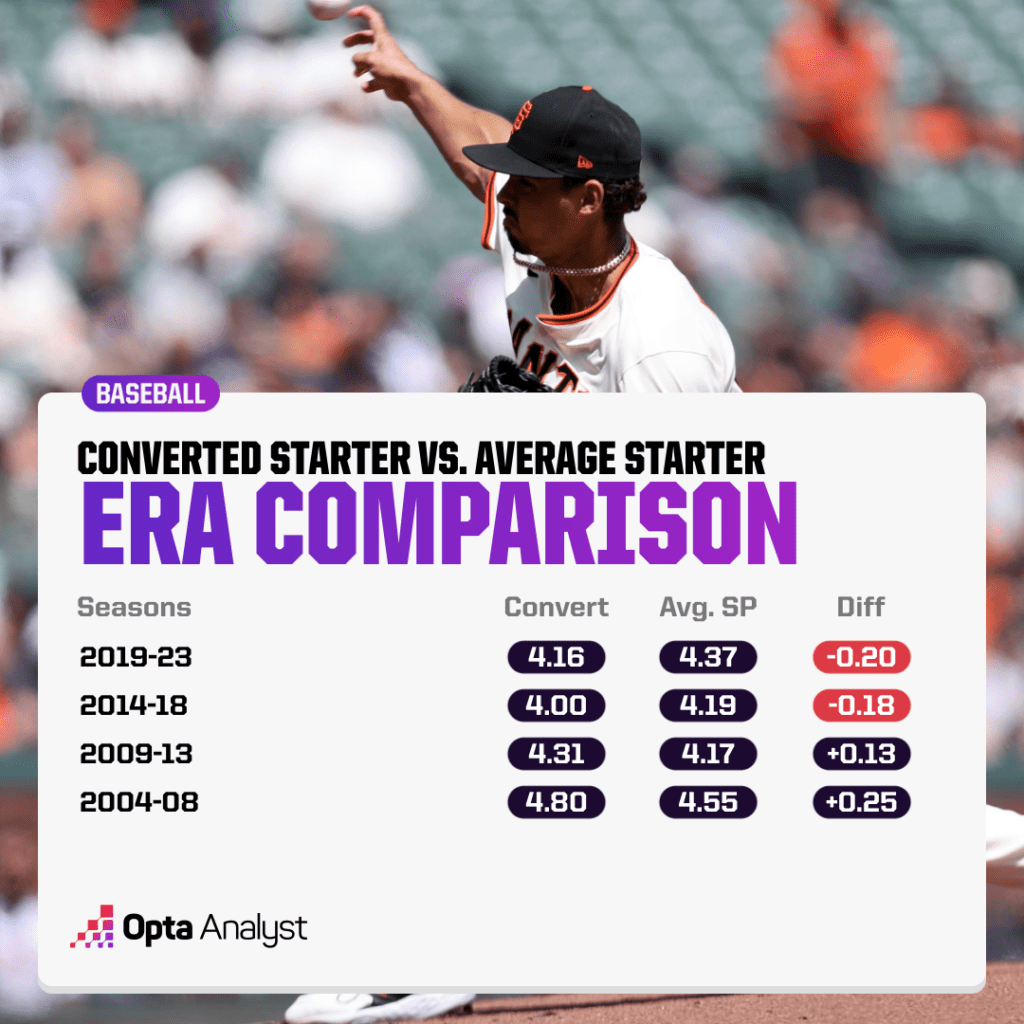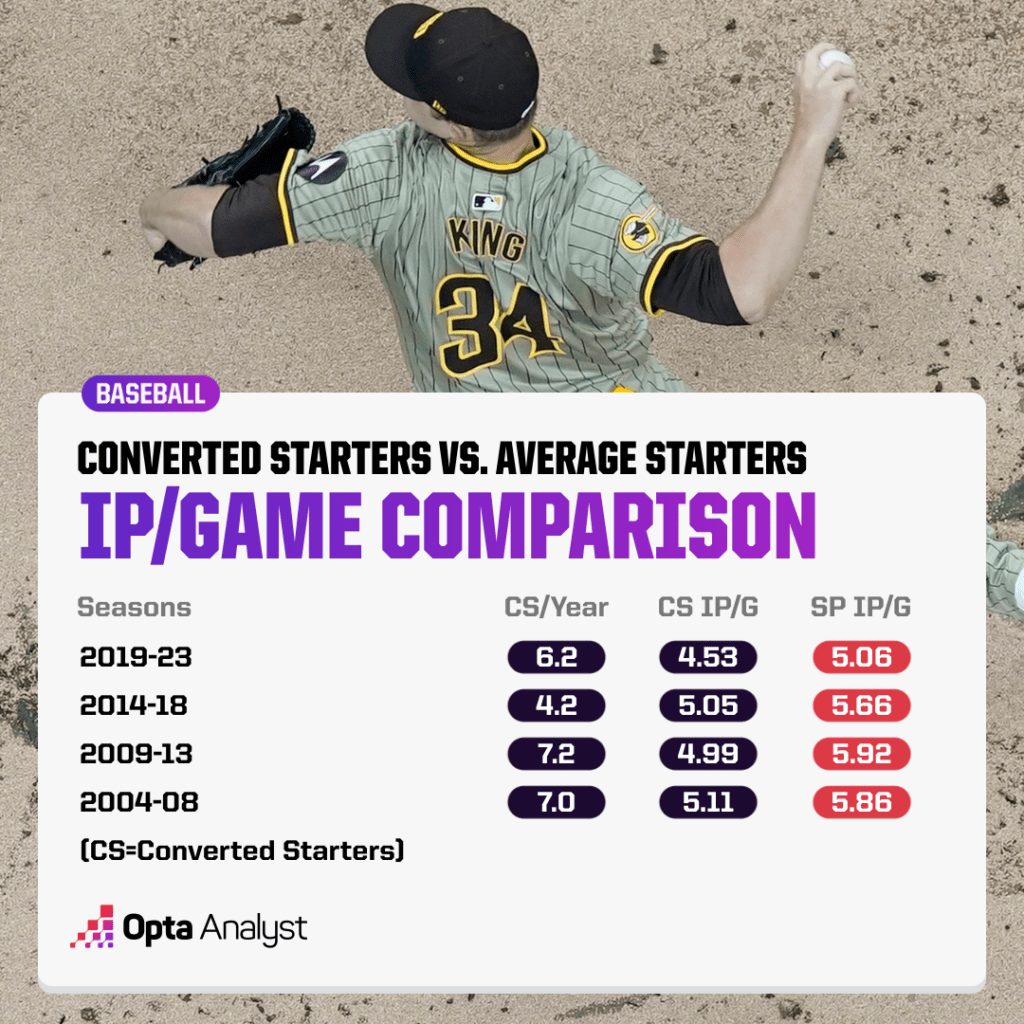When the Tampa Bay Rays moved Zack Littell into the starting rotation last July, he was 160 games into a major-league career that, by all indications, would be spent as a relief pitcher. He had started six games, but more than half of those came as an opener.
The 6-foot-4 right-hander, now 28, had come up with the Minnesota Twins, quickly shuffled into the bullpen, then found success in that role for the San Francisco Giants — especially in 2021. He found himself bouncing around the league after that, landing with the Rays early in 2023, clinging to a mindset that he distills simply: “Whatever keeps you in the major leagues.”
“Would I have liked to have started? Sure,” Littell told Opta Analyst, “but it wasn’t something that I thought was ever going to be presented again, at least not in the major leagues.”
A rash of injuries just before the trade deadline last summer led the Rays to present him that idea. He took an intermediate step with a 3.1-inning outing in mid-July, then joined the rotation permanently on July 30. He ran a 3.72 ERA the rest of the way, striking out 48 and walking only seven batters in 65.1 innings.
Including his strong start this year, he has a 3.61 ERA since that day, a top-25 mark in baseball among pitchers with at least 80 innings, sandwiched between the likes of Zac Gallen and George Kirby.
And while his performance is in league with established rotation workhorses, Littell recognizes a growing class of hurlers like him: Converts who were bullpen staples before making the leap to the front of the game.
Just this season, there are a half dozen notable pitchers attempting the transition — from Jordan Hicks with the San Francisco Giants, to Garrett Crochet with the Chicago White Sox and Michael King with the San Diego Padres. The first no-hitter of the 2024 season was thrown not by a well-worn ace, but by the Houston Astros’ Ronel Blanco, who entered the year with only seven starts in 24 career games.
“I think you’re starting to see it more and more,” Littell said. “There’s some indicators like you look at the bullpen guy and he throws a lot of strikes. He punches out a good amount of guys. He doesn’t walk guys. He might give up some more hits in the bullpen, but as a starter you can kind of get away with that.”
We wanted to know if that feeling bears out in the data. Are more of the league’s starting rotation spots being filled by converted bullpen arms? And if so, is it working?
There are very few new ideas in baseball, and this isn’t novel either. In the game’s constant cycles of strategy, the difference is often in how the ideas are applied.
Converting relievers to the rotation had a hey day a little over a decade ago. You might remember failed attempts by the New York Yankees (Joba Chamberlain) and Boston Red Sox (Daniel Bard), but there were simultaneously huge success stories, including two in Chicago as Chris Sale and Jeff Samardzija took flight. Then it fell out of fashion.
But the data shows a new surge over the past five seasons, as teams experiment and reimagine the priorities of player development.
We looked for pitchers who had played in at least two previous MLB seasons, starting less than half their games in all those seasons, before posting a season primarily as a starter (minimum 10 games pitched). Over the past five completed seasons (2019 to 2023) an average of 6.2 pitchers per season have made the jump. Over the previous five seasons (2014 to 2018), only 4.2 pitchers per season did it.
This season, seven pitchers who would meet our qualifications have already made at least three starts.
- Jordan Hicks, Giants
- Garrett Crochet, White Sox
- AJ Puk, Marlins
- Ronel Blanco, Astros
- Michael King, Padres
- Garrett Whitlock, Red Sox
- DL Hall, Brewers
And if the results are any indication, that number might keep rising. Relief converts had worse ERAs than the MLB starter average in every season but one from 2003 to 2014, but they’ve had better ERAs than the MLB starter average in every season since 2015.
In that earlier 2009 to 2013 surge, when 7.2 pitchers per year were making the switch, the converted relievers compiled a 4.31 ERA that didn’t quite match up to the overall MLB average ERA for starters at 4.17. Now? The new converts have outperformed the norm since 2019, running a collective 4.16 ERA in their first season starting versus the 4.37 ERA among all MLB starters.

Littell has a theory as to why the arms tested by the fires of bullpen duty are thriving.
“When I was in the minor leagues, I would have argued this ’til I was blue in the face, that I was ready to pitch in the big leagues at 22,” he said. “But I wasn’t. Development matters.”
He can rattle off all sorts of ways he grew as a player by experiencing the grind of the major leagues in the bullpen — honing his routine and his flexibility to perform when it’s thrown off, gaining mental stamina, learning to get outs on days he didn’t have his best stuff. Looking around the league, he figures there are plenty of pitchers like him, pitchers who had enough talent to be summoned to the big leagues, but hadn’t had enough experience to build out a starter’s toolbox.
“I just think that the leash is really, really, really short if you’re not like a frontline rotation prospect, the Paul Skenes or that type of arm,” Littell said.
Instead, teams are finding productive roles for good young arms. Two of this season’s most prominent conversion projects — Hicks and Crochet — zipped to the majors before their 22nd birthdays because their firepower was so useful in relief. Now they’re harnessing their talents in a different role that could be even more valuable, long-term.
For the most part, early results have been positive for the pair. Even after losing his last three starts, Crochet is sixth among all qualified starters in raw value- (RV-), and second in whiff+. Hicks, the flamethrower who has leaned into his ground-ball tendencies, is solidly above average himself with an 80 RV- through five starts.
But these high-profile, high-velocity prospects turned bullpen aces might just be the tip of the iceberg when it comes to rotation potential.
One unavoidable truth about the state of pitching right now: Starters and relievers have never converged so closely in terms of how they exert themselves. Both are pushing to maximize their velocity and movement, while the starters’ share of the workload is leaking away into the bullpen.
From 2019 to 2013, converted relief arms averaged 4.99 innings per outing, while the average MLB starter was twirling 5.92 frames per start. Over the past five seasons, the average MLB start has lasted only 5.06 innings, making the converts’ 4.53-inning average far more palatable.

The logic works both ways. If relief pitchers can more readily approximate a starter, then perhaps a young starter can intentionally pivot to relief to gain experience without really risking his future role. If there’s one team that seems to have jump-started the recent surge of converts, it’s the Milwaukee Brewers.
They weren’t taking mid-career bullpen regulars and putting them on the marquee, but instead using major-league bullpen time as a stepping stone for real starter prospects. Both Corbin Burnes and Brandon Woodruff took that path en route to becoming aces.
With or without intent behind the experience, Littell said battling major-league hitters has serious, if intangible, benefits.
“There’s that learning curve getting in the major leagues and learning how to get major league guys out on a daily basis,” he said. “So getting to pitch in the bullpen for a year — two years, three years, whatever it is — it gives you that experience of being a major-league pitcher and understanding what it takes while also continuing to develop.”
King, who started throughout his time in the Yankees system, tread a version of this path. He found dominance in relief, got a taste of the rotation in the Bronx and then went to San Diego as a prize of the Juan Soto trade, where he’s being used as a full-fledged starter. Across the league, there is generally more fungibility in pitcher roles. The average convert over the past five years had already started 22.7% of their games before making the switch. Back in the span starting in 2009, they had started only 14.7% of their pre-transition games.
Even with the evidence that plenty of relievers might have more in the tank, it often takes fresh eyes to see their potential. Of those seven pitchers attempting it right now, three changed teams and three more saw an offseason change atop their existing team’s front office. Only Blanco has made the shift under “stable” conditions, where a rash of injuries greased the wheels.
Though they don’t meet the criteria to be included in our data, veteran pitchers such as Seth Lugo, Michael Lorenzen and Reynaldo Lopez have also returned to starting after long detours in the pen. Lopez is attempting the shift for the Atlanta Braves right now, while Lugo and Lorenzen made the move in 2022 and 2023, respectively.
Hicks, in particular, reflects both the game’s growing willingness to experiment and the way individual teams can get tunnel vision about their own players. If he completes the transition this year — after pitching 212 games and starting in only eight of them, mostly for the St. Louis Cardinals — he’d be one of the 10 most experienced relievers since 2000 to become a starter.
So far, the legitimate concerns about his control haven’t sunk the starter experiment. Hicks is running the lowest walk rate of his career thus far, and his 96 command+ is close enough to average that it won’t raise eyebrows.
Sure, there have been failures (A.J. Puk struggled and has been moved back to the Marlins ‘pen). But if Hicks or Crochet or King thrive the way Littell has, or reach even greater heights, there will only be more impetus to search for the next ace not just in the draft or in the farm system, but in the later innings, where growth is happening with each and every pitch.
“I had a lot to learn, and still a lot of development to go on, and I didn’t get an opportunity to do that as a starter in the major leagues, which is understandable,” Littell said. “I’m not faulting anyone for that. Teams can’t wait but so long, but there’s a lot of guys in the league that probably could be decent starters.”
Research support provided by Stats Perform’s Chase Weight. Follow us on X and Instagram for more!
